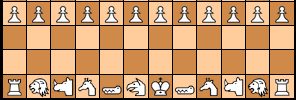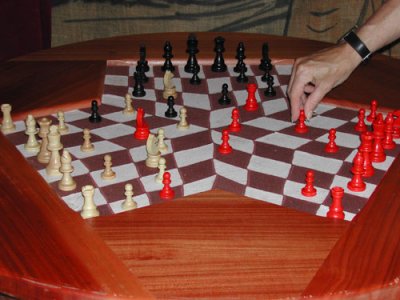Comments/Ratings for a Single Item
- how does Yalta compare to other three-player chess variants? (I'd come across it as a teen, so have a soft spot for it. It also looks like a more direct extension of two-player chess than some others that I've seen - which I also like.)
- is there anyone who makes Yalta chess mats?
The rules should be made more exact rather than "All disagreements at the table (about the rules) are solved by casting votes among the three participants."
Here are some of my ideas about the movements (I don't know if they are correct):
- Orthogonally is to a cell sharing an edge and having a different color.
- Diagonally is to a cell sharing a corner but not an edge, and having the same color.
- The forward lines for red are: QR1-QR2-QR3-QR4-KR4-KR3-KR2-KR1, QN1-QN2-QN3-QN4-KN4-KN3-KN2-KN1, QB1-QB2-QB3-QB4-KB4-KB3-KB2-KB1, Q1-Q2-Q3-Q4-K4-K3-K2-K1, K1-K2-K3-K4-Q4-Q3-Q2-Q1, KB1-KB2-KB3-KB4-QB4-QB3-QB2-QB1, KN1-KN2-KN3-KN4-QN4-QN3-QN2-QN1, KR1-KR2-KR3-KR4-QR4-QR3-QR2-QR1, Q4-Q3-Q2-Q1, QB4-QB3-QB2-QB1, QN4-QN3-QN2-QN1, QR4-QR3-QR2-QR1, K4-K3-K2-K1, KB4-KB3-KB2-KB1, KN4-KN3-KN2-KN1, KR4-KR3-KR2-KR1.
- Knight moves one space orthogonally followed by one space diagonally, jumping over whatever is in between, but cannot land on a cell orthogonally adjacent to the cell it is moving from. (Example: a knight on K4 may move to QB3, Q2, KB2, KN3, QN4, QB3, K3, Q4, and KB4.)
- A diagonally forward move (for pawn captures) is a diagonal cell which is the forward cell of a orthogonally adjcent cell and which is also orthogonally adjacent to the forward cell. (Example: a red pawn on K4 can capture on QB3 but not on K4; a red pawn on Q4 may capture on K3 and QB3.)
- Note that K4 isn't adjacent to Q4 (it doesn't meet the definitions above), so only knights can move from one to the other.
- A move from Y to Z is in the same direction as a move from X to Y iff all of the following conditions hold:
- X isn't adjacent to Z.
- X, Y, and Z are all different cells.
- X and Z must touch opposite sides/corners of Y.
Here are some of my other ideas of rules (some of which differ from the article and/or comments):
- A pawn promotes if there is no more cells directly forward of it.
- There is no check (this also means you are allowed to castle through check, and move into check, etc).
- If you capture a king, all other pieces of the same color as the king change to your color, except for pawns, which are removed.
- If all pieces are one color that player wins.
- You may pass if you have no legal moves, but if there are two successive passes (not three) then the game ends in a draw; if one player is already eliminated, that player still loses though.
The game comes from the Yalta conference after WW2. It was invented to reflect the three way fight between the USA, Britain and Russia. http://en.wikipedia.org/wiki/Yalta_Conference
Yalta 3 Players Chess: TheHug Vs. tomski1981 Vs. Vytron

The board game Yalta was created shortly after the 1945 conference and supposedly gave a better feel for how the conference went than any of the commentaries on the meeting. The treating of millions of lives as though they were pawns on a chess board, plus the continually changing sides ... (Gratuitous political comment deleted - Editor.)
Its very different from my original idea, but go for it! Do it! Its very interesting. Hugs.
I was thinking of posting similar game, but instead second queen, FIDE had cardinal (B+N) and pawn may promote to marshal (R+N) and camel ((1,3) leaper). Plus, as Xiang-qi looks as weakest player, it have additional two pieces: it moves as camel-mao (two squares orthogonally, when diagonally outwards) on home territorry, but it moves as rook on FIDE and shogi territrries (based on additional pieces from original 3-players XQ variants). When shogi captures pieces of other teams, it can be dropped, and it transforms into corresponding shogi piece (cannon and marshal transforms into shogi rooks, cardinals and vaos (see below) transforms into shogi bishops, camels and XQ additional pieces transforms into piece, Charles Gilman calls 'hump' - leaps 3 forward and 1 sideways on same move, promotes to gold general). Victory is achivied by capturing both hostile kings. XQ king may capture other kings either by rook rifle-capture, or move like rook to it's square (when cannot go to palace again. advisors can move out of palace and elepants cross river when, but not return back). All pieces conquered player had, now changes sides and transforms into corresponding piece (cardinals and shogi bishops transforms into vaos, diagonal cannons). Promoted shogi pieces become unpromoted, but FIDE pawns don't (and they also don't demote when captured by shogis, i forgot to say it). Turn order: Xiang-qi-Shogi-FIDE. In beggining, XQ cannons can capture FIDE knight or shogi bishop (second is not recommended, it will give advantge to shogi). I also have team variant of this (it's not complete, i still have to think about it): 2 players are team, but third player have strong king: FIDE chess - maharaja (R+N+B), XQ - yitong (R+XQ horse+cannon), Shogi - lion (see description of chu shogi or piececlopedia). What do you think about it?
I've been thinking, it's problably crazy, but if we make a 9x10 board we could make a FIDE x Shogi x Xiang Qi. The most significant change would be another queen to FIDE. Shogi wouls promote on any three last ranks and Xiang Qi would be the same. Hugs.
http://www.cie-maxi-jeux.com/animations-prestations/catalogue-jeux/jeux-en-bois-geants/jeux-reflexion-strategie/jeu-d-echecs-a-3---yalta.html
ps for moderate : i'am not a commercial and have no interrests of any kind in this sociéty it's just for example
this game is really different than classical chess but very interresting cause of many combinations and psychologic job
during the game we speak very much for mental intoxication
rules are ending amazing cases and sometimes we scratch our heads
the most important thing the timing of actions when you're checked by the first,the second is free to attack any piece cause you should face to the check before but sometimes he must defend you to avoid mate,your worst ennemy for the king is always the first and the second is the queen's killer
anyway take care of knights (crazy displacements near the center) thirty five years ago i've drawn many plates of three player's chess plates before it was really created and sold and the more useful was more rounded in the center(best global viewing of lines and columns) prefer hex plates than square
it is at last an excellent game ,try it and you'll be addict (or crazy;-)
ps sorry for my poor english cause i'am old french player
I've just started playing this game and it is a hoot. One decision we came to quickly is to dispense with the whole notion of check and check mate. They don't exist. A player loses when his/her king is captured. Why? Suppose player1 moves a piece which exposes player3's king to a piece of player2's. Now it's player2's move. Can he take the king? Of course he can and thus ends the game for player3. Not allowing player2 to capture the king would be silly. Try this. I'm in check, but another player is going to intervene before my king can be captured. Do I have to move out of check? Again only one answer makes logical sense. Of course I really have to trust the alliance to let my king wave in the wind like that. There are a thousand variations on this, but they all boil down to the same thing: you take the king or you don't take the king; there is no check. With the exception of not being allowed to castle through check, everything else about it can be explained as mere convention. Checkmate is nothing more than the king being captured on the next turn. Check is nothing more than warning the other person that this is about to happen. I think the game of chess would work perfectly fine if the conventions of check and checkmate had never become common.
 Cees Kleinveld wrote on Sat, May 27, 2006 12:56 PM UTC:Excellent ★★★★★
Cees Kleinveld wrote on Sat, May 27, 2006 12:56 PM UTC:Excellent ★★★★★Fun game, for those who want an easy to print board you can download a 4 x A4 pdf from here: http://www.shef.ac.uk/kevingillan/journal.htm cheers!
Having played a lot of this game, I have some rule clarifications the way we play them. 1) Knights. Move diagonal + straight or straight + diagonal, but do not land on a square touching the square they started from. From c4 there are 9 possible moves (the usual 8 on the red-green board + blue d4), from d4 there are 10 (the usual 8 on the red-green board and blue c4 & d3). 2) The king is the only piece able to move to the square of opposite colour in the center (red d4 to blue e4). 3) Tournament scoring: Whenever a player is checkmated this ends the game. If he is in check by one player, score 2 - 1 - 0, if he is in check by both opponents, score 3/2 - 3/2 - 0. If a draw is reached, score 1 - 1 - 1.
 Phil Brady wrote on Tue, Feb 4, 2003 01:48 PM UTC:
Phil Brady wrote on Tue, Feb 4, 2003 01:48 PM UTC:You can find a PDF with a piece of the board at http://www.ee0r.com/tri-chess/ (Look for the section titled 'What You Need'.) The page is about a chess-like game using Icehouse pieces, and so the board isn't colored quite right, but it's still useable. Be sure to look at the very bottom--there's an interesting way of making a five-player board with the PDF.
 Bryan wrote on Mon, Feb 3, 2003 01:58 AM UTC:
Bryan wrote on Mon, Feb 3, 2003 01:58 AM UTC:I don't think the 2-vs-1 scenario is all that big of a problem in 3-player games, since if one player begins to pull ahead, it only becomes natural for the other two to ally against the leader. One problem in 3-player strategy games I've seldom seen solved though is the kingmaker problem. Suppose one player is losing hopelessly, but is either able to hurt one of the other players enough on the way out to give the other one the game, or is able to determine the winner more directly (by deciding whose mating trap to walk his king into...). Then the winner ends up being decided not by who played better, but by whom the _loser_ was feeling better disposed towards.
 Jianiyng Ji wrote on Sat, Dec 14, 2002 10:14 PM UTC:
Jianiyng Ji wrote on Sat, Dec 14, 2002 10:14 PM UTC:The last comment is quite interesting. Would probably make a great suggestion for rule 0 for 3 player games. It prevents that great bane of games for greater than 2 players, especially 3 players, 2 against 1 senario.
25 comments displayed
Permalink to the exact comments currently displayed.

